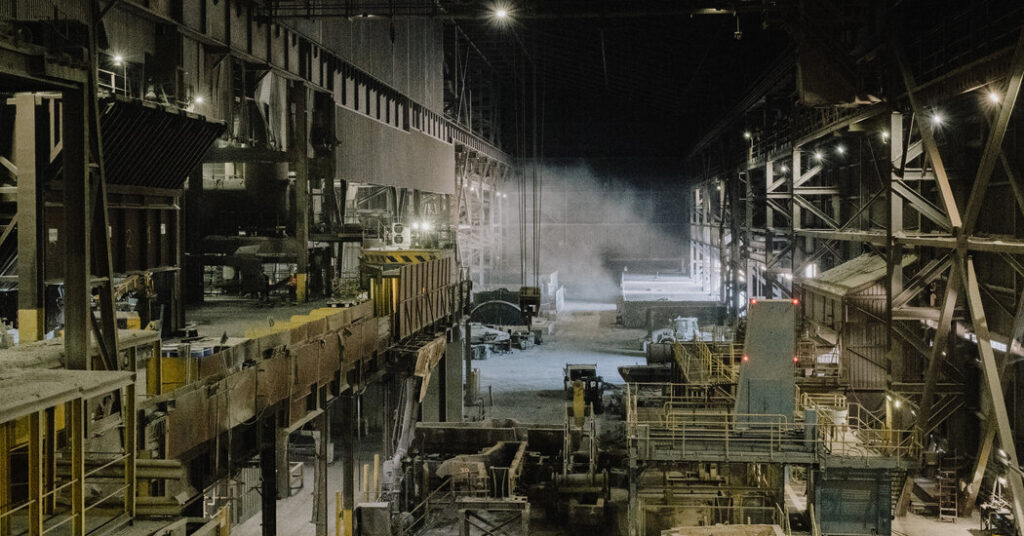The call from a supervisor came to the steel shop floor in Sheffield, England, on Thursday afternoon: The tariffs were off. “Everything had changed for us,” said Richard Bott, as he stood near stacks of steel slabs still radiating waves of heat from the mill.
In a trade deal with Britain announced with much fanfare on Thursday, President Trump agreed to lift the 25 percent tariffs on steel that had posed a dire threat to Britain’s struggling industry and to Mr. Bott’s employer, Marcegaglia Stainless Sheffield.
The cavernous plant is one of the last remaining large steel-making facilities in a city that since the 18th century was a hub of innovation in the industry.
The plant is now old and dusty, but it is in some ways avant-garde. It uses an electric furnace, a technology the government wants other mills to adopt to reduce emissions, to melt piles of sparkling stainless steel scrap into molten metal.
Marcegaglia, part of a family-owned company in Italy, ships more than 100 million pounds’ (or about $133 million) worth of steel from Britain to the United States annually, around a quarter of the country’s steel exports.
The U.S. tariffs, which were announced in February but went into effect in March, added substantial costs and complexities to what was already a declining industry. British steel makers are struggling with weak demand, outside competition, and high energy and environmental costs.
The difficulties were highlighted recently when the government took control of Britain’s last major steel mill, at Scunthorpe, about a 90-minute drive from Sheffield, fearing that the plant’s Chinese owners would shut it down.
Marcegaglia, which ships finished and semifinished stainless steel products to the United States, where it has a mill in Richburg, S.C., was seeing “a slowdown in demand as customers decided whether they wanted to pay the 25 percent duty or not,” said Liam Bates, a Marcegaglia president.
In one effort to mitigate the damage, Marcegaglia raced to load a barge with steel and send it across the Atlantic to arrive before the tariffs took effect, but it arrived too late, adding millions of dollars in costs.
On Friday, there was a cautious sense of relief at the plant, which employs 440. “It’s good news for the company and the country,” said Ryan Johnson, a project engineer.
Christian Bruggmann, the plant’s chief operating officer, said he had thought tariffs would be lifted on much of the material that Marcegaglia exported to the United States. “At least some of our customers in the U.S. will pick up the phone and try to make it work,” he said.
Company officials, though, say they still don’t know what the deal means for products that are shipped from Britain to European Union countries like Sweden for further processing and then on to the United States.
The 25 percent tariff on steel imported into the United States is still in place for other countries. What tariffs will wind up applying to the European Union remains to be seen, creating a large unknown for a British business that sends large amounts of its output to both Europe and the United States.
The Trump administration’s impulsive approach to trade policy also creates uncertainty and saps confidence, they say.
“There doesn’t seem to be a structure, so you can’t plan anything,” said Tracey Wilshaw, the plant’s planning manager. “Which doesn’t give us any stability at all.”
Still, Ms. Wilshaw said she was more optimistic after Thursday’s announcement.
Steel UK, an industry group, welcomed the easing of tariffs, saying the United States was Britain’s second-most-important market for steel after the European Union, accounting for about 9 percent of sales by volume.
Britain’s prime minister, Keir Starmer, has risen to the defense of the domestic steel industry recently, but these businesses are dwindling and remain endangered. Only 35 percent of demand for steel in Britain is now met by domestic production, according to Steel UK.
Dave Brooks, the manufacturing manager at Marcegaglia, recalled joining the steel business as a 16-year-old trainee in 1986 and having the opportunity to work at other facilities, including a research and development center.
These units, he said, have all been closed in the waves of corporate takeovers and consolidations in the British and European industry in recent decades.
Still, steelworkers seem to be a resilient community that mostly enjoys the work and sees little point in looking at the downsides.
“Just grin and bear” it, said Simon Flynn, a contractor.


